ISSN ONLINE(2319-8753)PRINT(2347-6710)
ISSN ONLINE(2319-8753)PRINT(2347-6710)
Mr. A.Ramkumar1, Prof.S.Gopalakrishnan2
|
| Related article at Pubmed, Scholar Google |
Visit for more related articles at International Journal of Innovative Research in Science, Engineering and Technology
Risk & problems in every walk of life. Likewise it exists in every construction projects also. Firstly all the risk factors are to be identified, understand the significance of various risks and its possible effects in the construction projects. If they are done so, then it will be so easy to mitigate to above risks, will have benefits in any construction projects productivity. This paper deals with identification & analysis of various risk factors, classification of risk, quantification of risks and problems by way of conducting a detailed survey among the engineers, contractors, and experts belong to various construction firms in the form of questionnaires. The above questionnaire has been conceived in such a manner that it has the details of profile of construction firm, their understanding about productivity and various risk factors. The collected data through the above survey the ranking has been done to find the greater risk factors which affect the construction project. Finally the rank index (I) formula for productivity risk index has been arrived. The formula arrived from this research paper is implemented in construction projects definitely the major risk factors will size ably get reduced. As a result the productivity will enhance remarkably. Thus optimum solution will be obtained. After determined the top ten risk factors the root cause analysis will be made and solution & suggestion will be given.
Keywords |
| Risks & Problems, Relative Importance Index, Project Delay, Root cause analysis. |
INTRODUCTION |
1.1 General |
| Construction projects are usually characterized by many varying risks. Being able to manage risks throughout the construction process in an important and central element preventing unwanted consequences. The construction industry is one of the most dynamic, risky and challenging businesses. However, the industry has a very poor reputation for managing risk, with many major projects failing to meet deadlines and cost targets. This is influenced greatly by variations in weather, productivity of labor and plant, and quality of material. All too often, risks are either ignored, or dealt with in a completely arbitrary way simply adding 10 percent contingency onto the estimated cost of a project is typical. In a business as complex as construction, such an approach is often inadequate, resulting in expensive delays and litigations. |
| Risk management is an important part of the decision-making process of all construction companies. Risk and uncertainty can potentially have damaging consequences for some construction projects. Risk can affect productivity, performance, quality, and the budget of a project. Risk cannot be eliminated, but it can be minimized, transferred or retained. Risk management is not a new concept. Traditionally it has been applied instinctively, with risk remaining implicit and managed by judgment, informed by experience. |
1.2 Project cultures, structures and processes |
| Limited involvement or no mandatory involvement of other functions especially finance in the business case development results in project cost overruns. The lack of multi-disciplinary team involvement in execution of major projects and traditional hierarchical structures curtail functional interface resulting in project schedule delays which might be contributing to major capital projects failure. 1.3 Aim, Objective and Research Questions |
| The overall aim of this project is to let everyone know what risk management is, realize the procedure of risk & problems in construction project and have a deeper study on the application of risk management during construction period, therefore, a better project output and better value for both clients and constructors. |
| On the basis of the aim and the objectives, research questions have been formulated |
| 1. What is the problems & risks in client side? |
| 2. What is the problems & risks in contractor side? |
| 3. What is the problems & risks in consultant side? |
1.4 Problem Formulation |
| As the most common and typical project types, construction projects have several characteristics such as specific objects: time restraints, cost restraints, special organizational and legal conditions, complexity and systematic Characteristics. For that, each investment project, it is a complex system, especially for the construction project; there are many risk factors and complicated relations, which will influence it. The complicated relations include Direct, indirect, obvious, implicit or unpredictable, what is more, |
| The various Risk factors will cause different severity of the consequences. If you do not consider these risk factors at all, or ignore the main factors, they will cause damage because of decision-making errors. Quality targets time targets cost targets are the three major objectives of construction project management. Especially in the construction project. |
| According to the above description of the background in this thesis, we know that risk management of construction period is the management on the time limit in uncertain conditions. As the accordance to construction project implementation, the technical and economic analysis is based on the prediction and judgment analysts make of future events. |
| For example, investment or time limit prolonged, productivity under design requirement, rising cost of raw materials, increasing labor fee, fluctuating product prices, changing market demand, loan interest rate and rate in foreign money, all these unpredictable effect even damage to an investment project. The uncertainties, which can be considered. |
1.5 Research methodology |
| Literature study and analytical research are my major learning methods, which play an important role in this report. Analytical research involves analyzing existing problems & risk information. Today’s world is based on information technology and huge amounts of information are available on all kinds of subjects. |
| In addition, to speak of, the report is more persuasive and practical based on the study of real case and visit of site manager. As a student lacking experience working on building site, the visit definitely has a critical effect on the conclusion of this report. |
1.6 Questionnaire form |
| Primary data was collected using a survey questionnaire. The questionnaire was used to gain insight into the reasons for project failures. A questionnaire was prepared to guide the collection of the correct data in a structured and logical format. The questions were structured to gauge an understanding of the current issues facing major projects and possible reasons for failures. |
| The questionnaire was divided into three stages and the sample of the questionnaire is attached. The formation of the stage was connected to the three research objectives of the research study. |
| First stage was designed to gather respondent’s background information such as age, race gender and years of experience in major capital projects |
| Second stage was meant to collect information on what is the respondent’s point of view on the project management approach currently followed in project. Third stage was designed to collect information on the respondent’s point of view on the alignment between the project goals and business objectives to ascertain if there was any. Then top ten critical factors to be find out. The questionnaires were distributed via on site to various projects project managers, experts in construction industry. These participants were briefed on the objective of the survey and were requested to complete the questionnaire within three weeks. |
II. METHOLODLOGY |
2.1 METHODOLOGY FLOW CHART |
| The methodology of research paper will be preceded by the following way of methods represented in the fig.2.1 flow chart. |
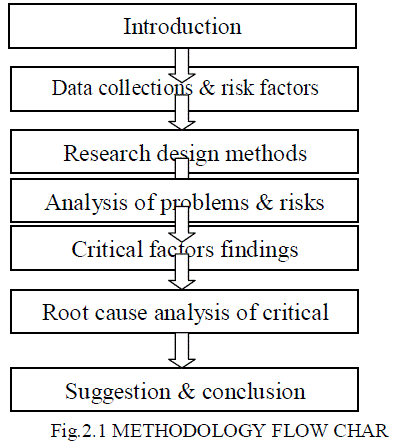 |
2.2 RESEARCH DESIGN METHODS |
| This chapter delineates the research design employed to analyze the root causes of major projects issues in construction industry. In addition, this chapter addresses the suitability of the research design and approach, and provides justification for the research design. The sampling techniques used are described. The instrumentation and materials, the reliability and validity of the instruments, data collection and analyses that explain the descriptive analysis used in the study, and the measures that were taken to protect the participants’ rights are also discussed |
2.3 Data collection from sites: |
| The data collection was done through prepared questionnaires. The suitable questionnaires are designed to collect appropriate data. The data collection is done from three residential and commercial projects. The construction sites with well-prepared bar chart are taken for this purpose. The planned data is compared to actual occurred data to know the occurrences of variation or delay in project progress, the bar chart scheduling is used as base line and the delayed time duration. And analysis of various causes of variation is done; to know the effect of each cause on the productivity of the project. For data collection purpose the quantitative method of data collection is adopted. The collected data is further used for analysis purpose. The collected data is used to know the variations in task, as well as for knowing the individual causes of variation. The individual causes are grouped in main cause groups depending on their characteristics and nature of occurrence on site. The onsite interviews are taken for this purpose. In which the care is taken that the all levels of authorities are involved in this process. The necessity of involving all levels of authorities is to consider the perspective of all levels of authorities towards the delay problem. And also it gives the exact causes of the variation in construction tasks. Data collection process is carried out on construction sites from the Coimbatore and erode region. The ten weeks data is recorded for data collection. And this data is used for data analysis. |
2.4 Data collection methods |
| Data was collected using questionnaire survey, distributed to all project managers involved in managing major capital projects and experts in construction industry. Data was also collected through focus group interviews conducted with the selected project decision-makers and expert interview method. |
| Focus group interviews considering the nature of the study, a convenience sample method was used to conduct a group focus interviews with Engineers designated as Project Directors, contractors and consultants. |
| The focus group interview helped finalize the design and content of the questionnaire. This was decided by the researcher given the time constraints for the study completion. |
| Describe this as a group of individuals selected and assembled by the researcher to discuss and comment on, from personal experience, the topic that is the subject of the research. |
| The main purpose of the focus group research according to respondent’s attitudes, feelings, beliefs, experiences and reactions in a way which would not be feasible using other methods, e.g. observations, one-on-one interviews or questionnaire surveys. |
| Comparing this to individual interviews, which aim to obtain individual attitudes, beliefs and feelings, focus group elicit a multiplicity of views and emotional processes within a group context |
| In conclusion, the article goes on to say that a focus group enables the researcher to gain larger amount of information in a shorter period of time. The advantages of focus group interviewing are much cheaper and quicker to run than intensive one-on-one interviews and respondents tend to be more complete and less inhibited. |
2.5 Identification of risks & problems |
| The identification of each source of risk, problems and components allow the risk item to be separated from others. Consideration of each influencing factor will simplify the analysis and management of risk. The key questions to ask is ‘what are the discrete features of the project (risks & problems) which might cause such failure?’ |
| The early identification of risks and problems, it focuses the attention of project management on the strategies for the control and allocation of risks. |
| Identification of risks and problems are analyzed from project managers, engineers and experts in construction industry. Each and every factor should be identified from group discussions between project management team in construction industry. |
| These factors should be analyzed and collected details through some of the case studies and international journals like NICMAR, ASCE & SCIENCE DIRECT. |
2.6 Questionnaire design: |
| Questionnaire is prepared with, the site information, interviewer position and his authority towards work, type of task and factors causing delay for that task. The questionnaire is divided into two main parts. First part is related to general information for both the company and respondent. Second Part includes the list of the identified causes of delay in construction project. These causes are classified into three groups according to the main sources of delay i.e. client, contractor and consultant related issues in construction firms. |
| For each cause group two questions were asked i.e. what frequency of cause occurrence is. And what is the degree of se-verity of this cause on project delay? Both the frequency of occurrence and severity were categorized on a five-point scale system. Frequency of occurrence is categorized as follows: strongly agree, agree, average, disagree and strongly disagree (from 5 point to 1 point on scale respectively).From which the severity index and the frequency index of the cause occurrence on site has came to know and which can further used in preparation of the risk assessment matrix. |
2.7 Site selection for data collection: |
| In this the variation survey will be done at three residential construction sites and then root causes of these variations will be found through questionnaires at different level of management. The site selection process is done with following criteria: |
| • The site should be residential and commercial type. |
| • Scheduled bar chart should be prepared for the work and the work is followed with scheduled bar chart. |
| • The site should cover maximum activities within data collection period. |
| The following three sites are selected based on the criteria for data collection purpose in Coimbatore and erode region. The sites are with well-prepared bar chart. Those data’s are collected from top and middle level companies, contractors, consultants and clients. All data’s and details are gathered from residential and commercial type of projects. Each and every activity process, risks and problems are effectively monitored from site and group discussions. |
| Observed information are verified and finalized from experienced project managers, engineers and contractors. |
2.8 Focus group interviews |
| Considering the nature of the study, a convenience sample method was used to conduct a group focus interviews with Chief Engineers designated as Project Directors and the project engineers in construction field.. The focus group interview helped finalize the design and content of the questionnaire. These five senior employees were excluded from the census. This was decided by the researcher given the time constraints for the study completion. |
| The main purpose of the focus group research according to Social Research Update is to draw upon respondent’s attitudes, feelings, beliefs, experiences and reactions in a way which would not be feasible using other methods, e.g. observations, one-on-one interviews or questionnaire surveys. Comparing this to individual interviews, which aim to obtain individual attitudes, beliefs and feelings, focus group elicit a multiplicity of views and emotional processes within a group context. In conclusion, the article goes on to say that a focus group enables the researcher to gain larger amount of information in a shorter period of time. |
2.9 Questionnaire form Part-I |
| First part is company and respondent profile. This part is designed based on the skills, experience and company details in respondent. |
COMPANY AND RESPONDENT PROFILE |
| 1. Organization/Company Name : |
| 2. Name of the person contacted : |
| 3. Type of job/position : |
| 4. Age ( Years ) : |
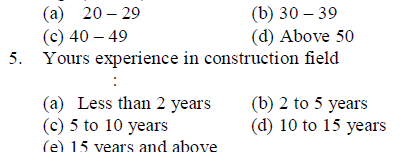 |
| 6. company experience in building and construction business : |
| (a) Less than 5 years |
| (b) 5 to 10 years |
| (c) 10 years and above |
| 7. Respondent sign & seal |
2.10 Questionnaire form Part-II |
| Second part is questionnaire survey factors. This part is designed depending on the risks and problems in construction industry. The survey was designed based on the 75 causes of delay shown in below to which participants were asked to indicate the level of importance of each cause. These causes were categorized into three major groups namely client, contractor and consultant. |
Client Related issues for construction delays |
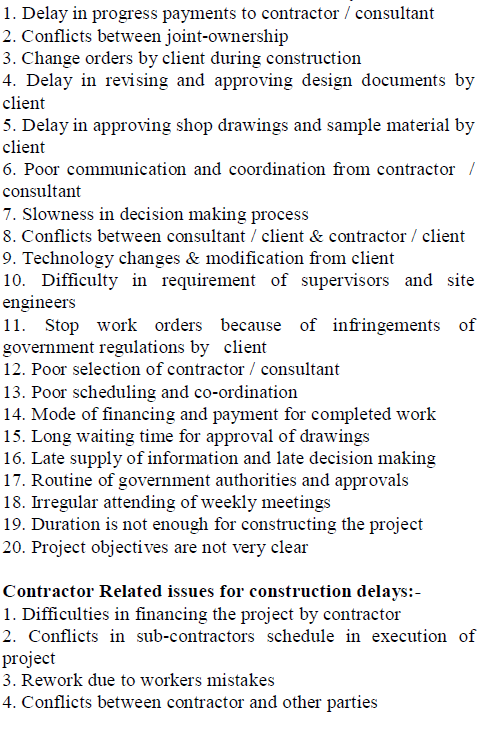 |
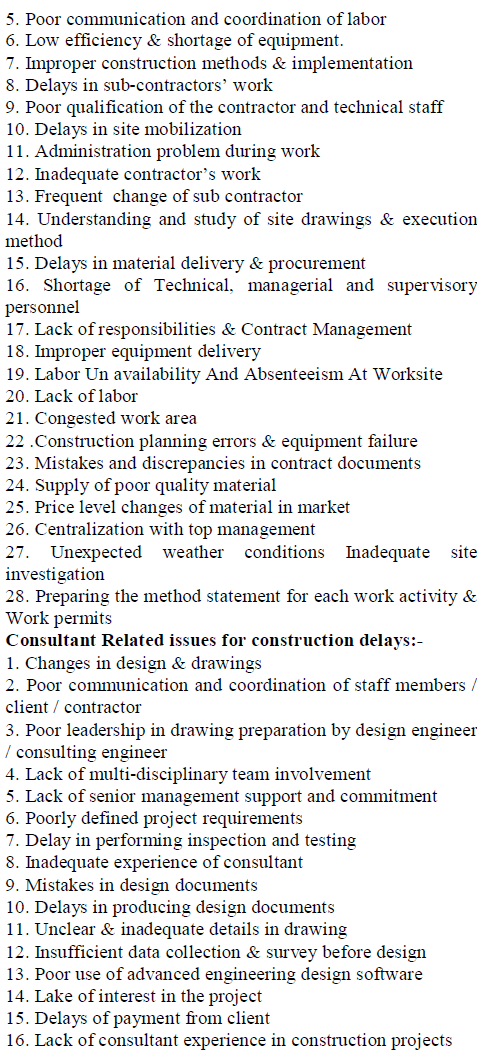 |
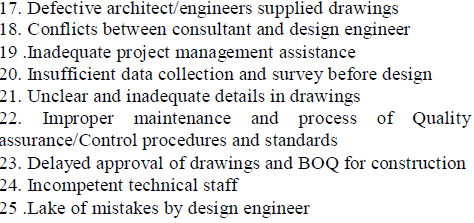 |
2.11 Final Format of Questionnaire |
| Final questionnaire formats are prepared with the support of experts in construction industry, project manager/engineer and construction management people. This risk factor will be finalized based on the focus group interview, feelings, experience and performance of working people in construction industry. |
III. ANALYSIS OF PROBLEMS / THEORETICAL CONCEPTS |
3.1INTRODUCTION |
| This chapter explores the problem further with theoretical concepts. The focus of this study is to analyze the root causes of major project issues and it is therefore appropriate to begin with a thorough account of the theoretical aspects of project management as a management approach. The concept of project management will be theoretically researched in this chapter to have a better understanding of the importance of project failure or success and the themes identified in chapter two will be further explored. |
3.2 PROJECT MANAGEMENT |
| The project management body of knowledge defines a project as "A temporary Endeavour undertaken to create a unique product or service (outcome or result). Temporary means that every project has a definite beginning and a definite end. Unique means that the product or service is different in some distinguishing way from all similar products or services." Table 3.2 below indicates some of the special features of a project. |
Table 3.2.1 Special features of the project: |
| Start and finish A project has a clear start and |
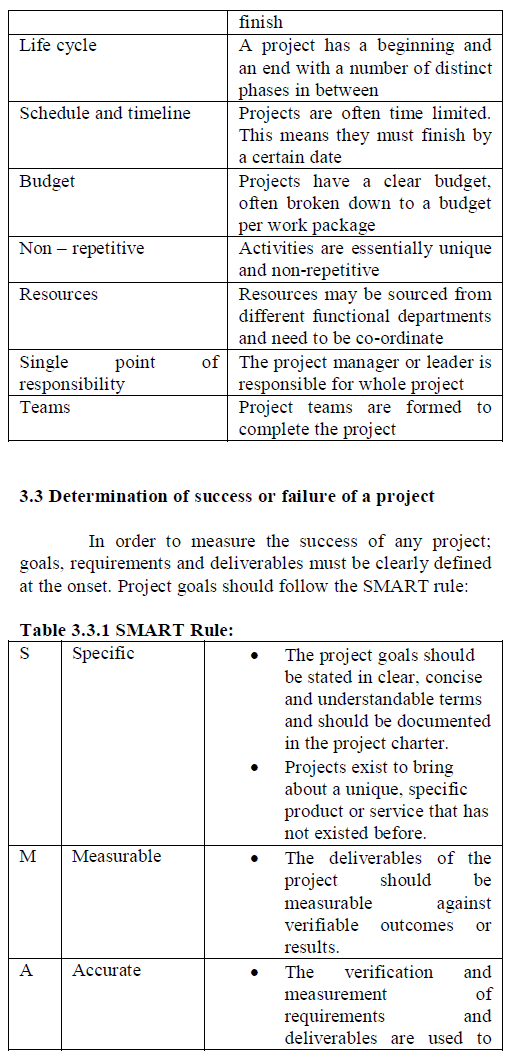 |
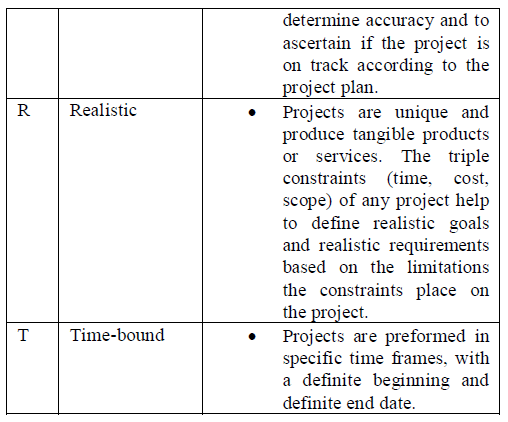 |
| Project requirements are not the same as goals and objectives. Requirements are Specifications of the goals or deliverables. If a project delivers on specification and the prerequisites that make up the product or service, then the project is deemed successful. Deliverables are measurable outcomes, measurable results, or specific items that must be produced to consider the project or project phase completed. Deliverables, like goals, must be specific and verifiable. Hence, identifying whether or not a project is successful can be easily accomplished if these parameters are clearly defined at the onset of the project |
| The new success criteria involve four dimensions developed from two data sets of major projects |
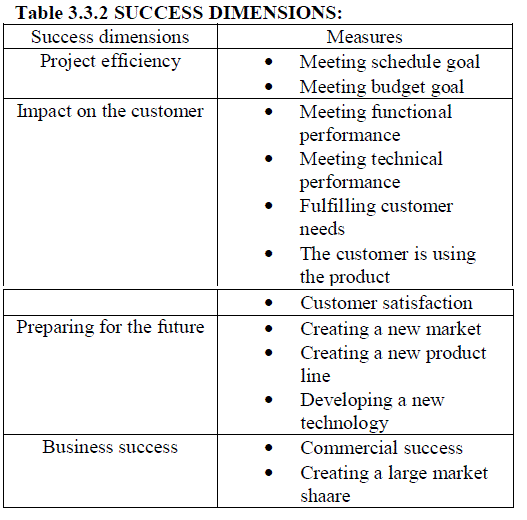 |
3.4 SOURCES OF UNCERTAINTY |
| Uncertainties and risk cause the range of problems during the implementation of construction project. In this part of article three parts are presented with description of uncertainty sources and possible consequences. Sources and consequences are combined in three groups to clarify the type of uncertainty source. |
3.5 Matrix organizational structure |
| The matrix organizational structure illustrates how the project structure overlays the functional structure and outlines the relationship between the project manager, functional manager and their subordinates. In this case the vertical lines represent the functional department’s responsibility and authority while the horizontal lines represent the project’s responsibility and authority The matrix structure is considered by many practitioners to be the natural project organization structure and can be applied at different levels ranging from weak to strong. The project manager's role is more one of a coordinator or expediter than that of a manager. In a similar fashion, strong matrices have many of the characteristics of a project organization that is full-time project managers with considerable authority and full-time administrative staff. It is widely agreed that the choice of management structures used to implement innovative, temporary, cross-functional and complex project endeavors has important implications. “successful organizations will have to change their business processes from being hierarchical, functional organizations to being fast tracking, entrepreneurial enterprises made up of portfolios of projects that are ever changing and renewable. This needs a faster, cheaper, better way of doing business embodied in a project management culture”. |
3.6 Cross functionality |
| In traditional hierarchical organizations, each functional area works in isolation on their part of the process and then passes the activity to the next department in a serial decision making process. The cross functional project team is typically comprised of people from several functional areas who, at one time or another are involved in the design, engineering or marketing of the product or service. The following key factors to building and maintaining cross functional project teams. Project sponsorship and upper management support: the project sponsor requests the project and holds the budget and resources for getting the project accomplished. In addition to full commitment of the project sponsor, management support from all affected areas is crucial in order for the team to have the time, resources and recognition to accomplish their goals. |
| • Project goals/ scope/ objectives: the project’s merit to the organization and its link to the corporate strategy and objectives must be clear to the entire organization and particularly to the project team. |
| • Leadership: the project manager must have a positive attitude, commitment to the project, effective leadership skills and be in a position of authority with respect to the project and the project sponsor. |
| • Membership/ resources: adequate team staffing and membership with complementary skills are critical to the success of any cross functional project team. |
| • Communication: communication is key to breaking down functional and physical boundaries when cross functional teams first form. Good communication with a high level of trust, honesty and respect is critical in building and maintaining high team performance |
| • Performance/ reward system: Cross functional team, member’s performance must be evaluated and rewarded within the team context and with equal weight to the work they do outside of the project. |
3.7 Project Portfolio Management |
| A portfolio of projects is said to ‘have a business scope that changes with the strategic goals of the organization and success is measured in terms of aggregate performance of portfolio components’ (PMI, 2006). |
| Project portfolio management is a methodology providing the necessary mechanism to bridge the divide between project and strategy execution. However, for project portfolio management to be effective, certain degrees of project management maturity levels need to be achieved before real benefits can be derived. Common challenges that face organizations not utilizing a project portfolio management methodology due to lack of visibility into their portfolio are: |
| • No formal process for aligning investments with business strategies |
| • Not able to priorities project requests from businesses competing for scarce Resources |
| • Inefficient and over allocation of the scarce resources (money. people. time) |
| • Allocation of scarce resources to “urgent" projects instead of 'important" projects |
| • No accountability of the business benefits through project life cycle through to post implementation level (only important while project is in execution stage): |
| • Projects high project failure rate |
| • Projects regularly exceeding available budget, time overruns and other tying down of the resources. |
| • While project management may help to an extent in executing a specific project within budget and time, it is ultimately the management of the portfolio that is responsible for selecting and prioritizing the right amount of projects that should be carried out. |
3.8 Project Maturity Level |
| A Project Management Maturity assessment model is a tool for establishing project management excellence, which is considered a condition for success. |
| Level 1 – Common Language: the organization recognizes the importance of project management and the need for a good understanding of the basic knowledge on project management along with the accompanying language and terminology. |
| Level 2 – Common Processes: at this level, the organization recognises that common processes need to be defined and developed such that project successes on one project can be repeated on other projects. Also included in this level is the recognition that project management principles can be applied to and support other methodologies by the company. |
| Level 3 – Singular Methodology: in this level, the organization recognises the synergistic effect of combining all corporate methodologies into a singular methodology, the centre of which is project management. The synergistic effect also makes process control easier with a single methodology than with multiple methodologies. |
| Level 4 – Benchmarking: this level contains the recognition that process improvement is necessary to maintain competitive advantage. Benchmarking must be performed on a continuous basis. The company must decide whom to benchmark and what to bench mark. |
| Level 5 – Continuous Improvement: at this level the organization evaluates the information obtained through benchmarking and must then decides whether this information will enhance the singular methodology. All companies desire to achieve maturity and excellence in project management. Unfortunately, not all companies recognize that the time frame can be shortened by performing strategic planning for project management. |
IV. CRITICAL FACTOR FINDINGS & ROOT CAUSE ANALYSIS |
`4.1 Causal analysis |
| The goal of the analysis approach was to identify common ‘root’ causes and establish a regime of measures that might be implemented to mitigate them in future projects. Through the analysis process, it emerged that the following categories were recurrent. 1. Client related issues in construction industry 2. Contractor related issues in construction industry 3. Consultant related issues in construction industry Based on the questionnaire survey and respondent ranking the top ten critical factors are determined and analyzed. Those problems and risks will be analyzed based on the feelings, attitude and risks in project managers, engineers and project consultant and contractors. |
4.2 Methodology for Findings |
| The methodology will be used in this paper by statistical in relative importance index methods (RII) |
4.2.1 Rating scale |
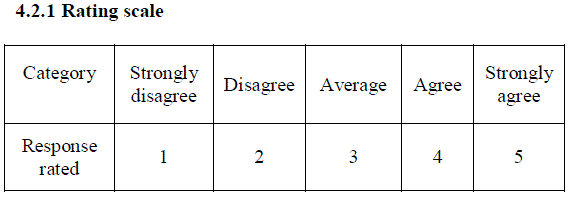 |
| (Rate the factor for the above Response rated) |
| • Rating scale will be arrived based on accuracy of statistical method. This weighting will be filled by respondents. • Respondents rank will be taken to find out the top ten critical risk factors in construction issues. • This ranking is given in the questionnaire form based on experience and knowledge of respondents. • This questionnaire forms are distributed to respondents through mail and direct interviews. • Formula used in relative importance index |
| RII = Σ (Xi x Yi) ÷ (Zi x 5) |
| Where, RII - relative importance index, Xi - number of responses of the factors, Yi - the value of rating, Zi - total number of responses to the factors. |
4.3 Root cause analysis |
| Root cause analysis of the top most critical factors is determined and gives suggestions and recommendations in construction industry. This method will be helpful to minimizing the project delays and reduce problems in construction industry. This approach will be mostly useful for project managers, engineers, contractors, clients and consultants. This process will be able to get reduce risks, problems and projects delays in construction industry. |
V. CONCLUSION |
| This thesis was studied and gathered information about issues and cause of construction delays in construction field. Based on this research paper information and details are collected from experts in construction industry and focus group interviews. |
| Finally questionnaire format was determined and finalized. This questionnaire format was prepared based on the three categories like client, consultant and contractor related issues in construction delays. |
| Each and every risk factor was identifying based on the construction project manager/engineer and experts experience, feelings and problems in construction field. |
| Questionnaire survey, analysis and identification of top ten risk factors and root cause analysis of those ten factors are determined in effectively and give possible solution to reduce problems and project delays in construction industry. |
References |
|